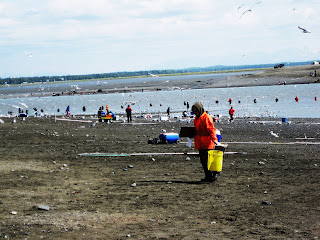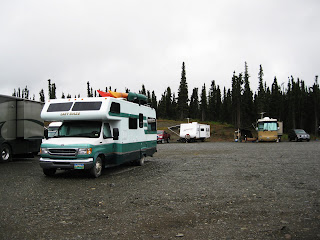A Village with a Past, a City with a Future.
The city logo says it all..... the Russian influence, the fishing, the oil drilling out in the Cook Inlet, and the beautiful volcanos of Mt. Redoubt and Mt. Iliamna, 51 miles away across the Inlet.
The Kenai convention and visitors bureau gave me a good summary of the history of the town: "The first people known to have settled in this area were the Riverine Kachemak, who occupied the Kenai and the Kasilof River areas from about 1000 B.C. to about 1000 A.D. Following the Riverine Kachemak, the Athabaskan speaking Dena'ina people came to the area, and remain here today as the modern Kenaitze.
"The Russian occupation of Kenai and Kasilof led to the Battle of Kenai in 1797. The Dena'ina defeated the Russians, and held the territory until the United States purchased Alaska in 1867. Only a few Russian fur traders remained in the area. In 1863, a small pox epidemic extinguished half the Dena'ina population. The people adopted a version of Russian Orthodoxy that included many traditional beliefs as a way to cope with the tragedy. In 1918, the influenza pandemic brought further losses to the Dena'ina, and many people from villages that were growing ever smaller moved to Kenai.
"In 1912 the first Libby cannery was built and commercial fisheries became the anchor industry of Kenai. In 1959 the Kenai gas field was discovered and Cook Inlet became the oil capital of Alaska. The discovery of oil and gas made the idea of statehood more attractive to the Federal Government and in 1959, Congress granted statehood to Alaska. "
The mouth of the Kenai River as it flows into Cook Inlet.
Mid-July marks the beginning of dipnetting season in Alaska. Dipnetting is a popular way for Alaskans to fill their freezers with fresh salmon for the winter. Dipnetting is open to Alaska residents only, so for us it was a spectator sport!
 |
Scenes from the beach! |
Many of the fishermen camped along the beach. To dipnet here, anglers stand in the mouth of the river holding large nets with long handles. When a fish swims into the net, they lift and twist the net to catch the fish. The fishermen cleaned their fish in the river and the gulls were ready to feast on what was left behind. This fishing frenzy is a sight not to be missed!
A man with a fish in his net.
Alaska has "personal use" laws for its residents which regulate their taking of fish, shellfish or aquatic plants for consumption as food or use as bait by an individual or his immediate family. In the Kenai River, the yearly limit for dipnetting is 25 salmon for the head of the household and 10 more salmon for each additional household member. In Soldotna we met a young man who catches 75 salmon each year by dipnetting. His only complaint was the length of time it took him to clean them all! Of course these same people can also go salmon fishing and get their limit everyday until the fishing season ends.
By law, a person may not possess salmon taken under a personal use fishing permit unless both tips of the tail fin have been immediately removed. That means before the fish are put into the ice coolers that stand at the ready. This law prevents the sale of these fish and protects the commerical fishermen's livelihood.
Fishing frenzy.
The fishermen cleaned the fish in the river and the gulls were ready to feast on what was left behind.
Nature's beachcombers.
When we were there the tide was going out so many fish parts which had been thrown into the river earlier were now strewn around on the beach as the tide receded. There were fish parts and skeletons all over and we had to watch where we walked.
Fireweed was in bloom on the bluff.
After our beach experience we walked around Old Town Kenai. The outstanding landmark there is the Holy Assumption Russian Orthodox Church which sits on top of the bluff. The plaque outside the church states that, "This church has been the principal and most enduring representation of Russian culture in southcentral Alaska from 1841 until the present. For the Kenaitz Indians it was the major institution for the assimilation of western culture when the Russian fur traders first came to the area. The church also served as the first school on the Kenai Peninsula educating the local Kenaitze children and young adults to read, write, grow vegetables and learn basic building methods. It served as a judicial center acting as arbiter between the officials of the Russian-American Fur Trading Company and the Natives. The church also provided the region's first access to public health with the introduction of smallpox vaccine after the first epidemic desimated the local population."
The Holy Assumption Russian Orthodox Church
There was a welcoming sign on the church steps so we went inside. There we met Father Targonsky. He is 80 years old and has served the parishes in this area for many many years. In talking to him I could not detect an accent, so I asked him where he was born. He told me he was born in Connecticut and had spent most of his summers as a boy in Springfield, Vermont. That is my hometown! How well I remember the Russian Orthodox Church on top of Park Street Hill. It was just down the street from where my Grandmother Woodbury lived. Next door to the church there used to be Hoskivich's Grocery Store. My oldest brother and I used to go there to buy popcicles to share. Father Targonsky told me he used to go there too. It was fun to think that maybe we had both been there at the same time, years ago, slurping popcicles on Hoskivich's front steps.
Yours truely and Father Targonsky.
The day we walked around Kenai was 65 degrees and sunny. It was the most beautiful day we had seen in weeks, and we just soaked up the warmth and the charm of this little town.
The "onions" are the symbol of the Russian Orthodox Church.
The town of Kenai seems to have two mottos. One I saw on the welcome sign as we entered the town and have used in the title of this post, "Kenai - A Village with a Past, a City with a Future". The other is written on their visitor brochure, "Kenai - Where the River Ends and Adventure Begins".
One motto seemed to define our experience in the church and the other, our adventure on the beach!




























